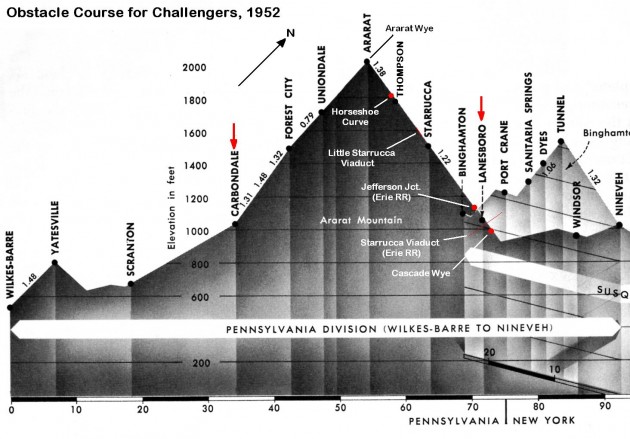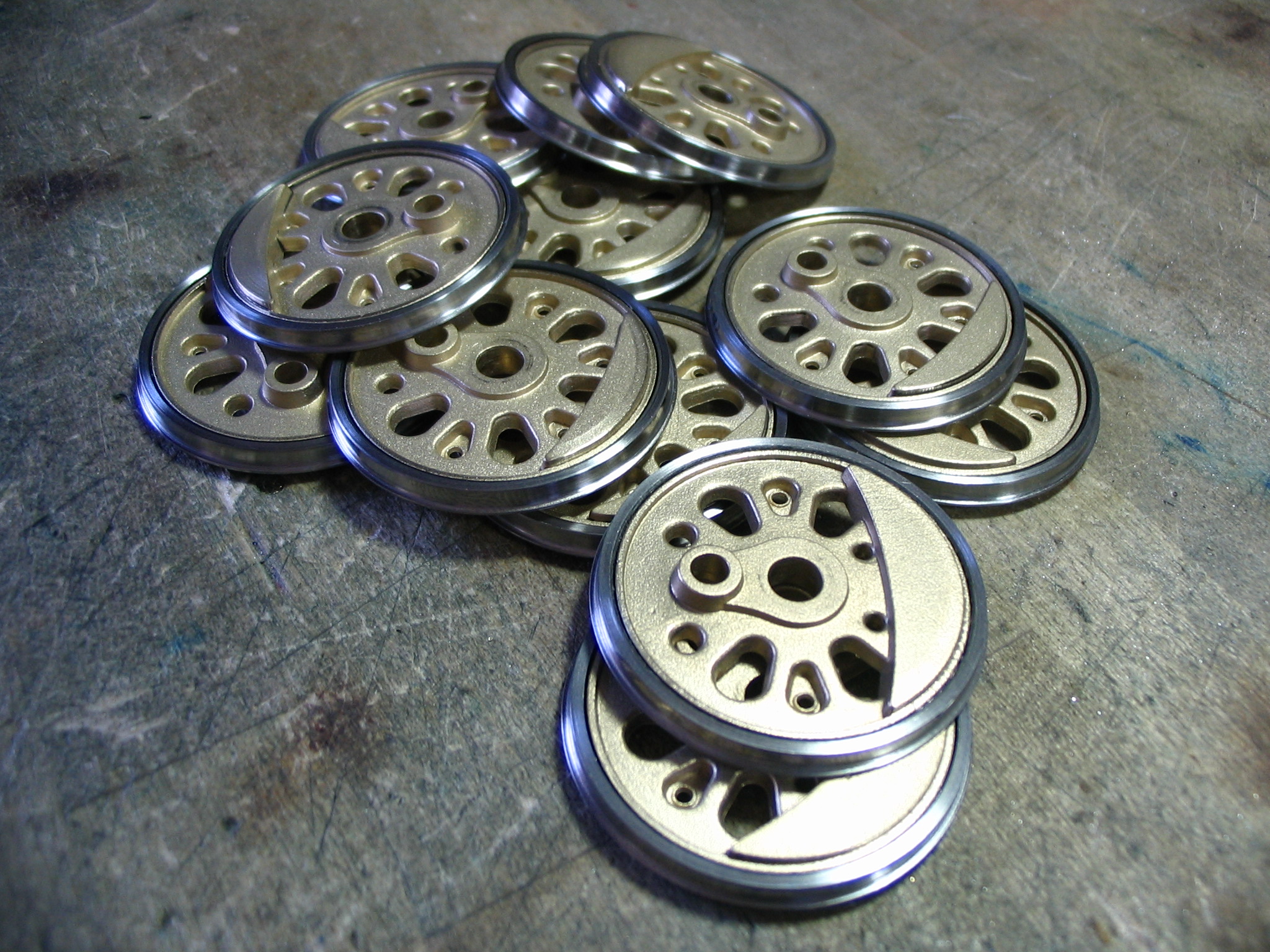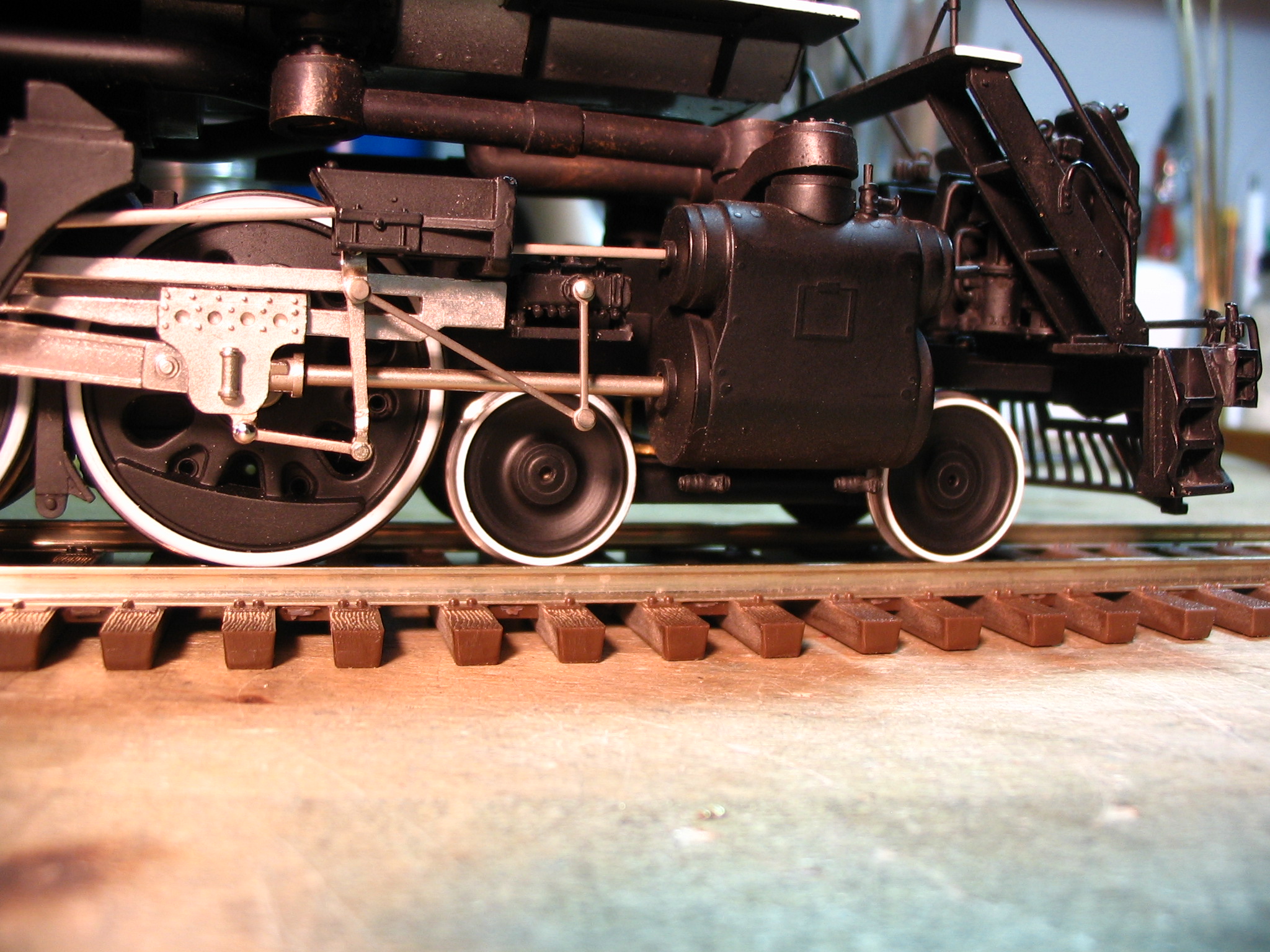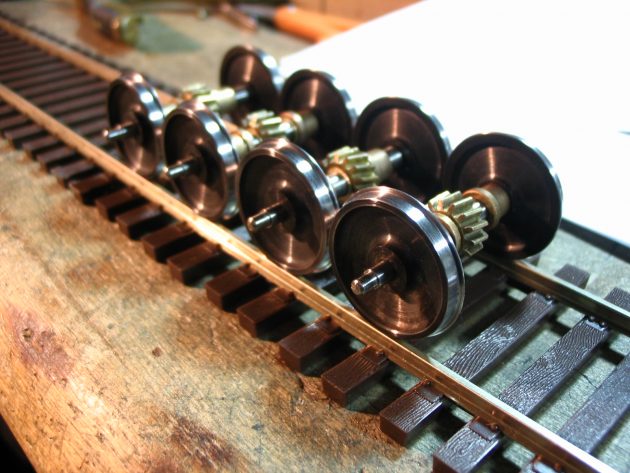Well, maybe if they were too wide to begin with. My problem in 17/64 scale O Gauge is finding cylinder blocks wide enough to have the main rods clear the front crankpins. When I work in 1 1/8" gauge, I breathe a sigh of relief.
rdunniii posted:Do you move the steam cylinders inward or put spacers between the drivers and the rods? Or...
Cylinder piston center-line to center-line is measured and checked against the builder's drawing(s). The dimensions on different model's cylinders can be all over the map. If they are too wide, the cylinder saddle and bolt flange(s) are removed, and they are cut in half. The inner edges (cut lines) are milled so that when re-assembled the final center-line dimension is correct per the drawing. Milling also insure a perfectly straight, smooth, near-invisible seam where the two halves are rejoined. Bolt flanges between the two halves are also rebuilt/replaced as needed.
The axles are shortened as required, so that when the drivers are pressed back on and quartered, their gauge meets the AAR spec.
Matt Forsyth
Penn Division posted:Gene D posted:Posting on this site is simply an effort on my part to share pictures of modeling. I am not on a crusade to convert list members to the Dark Side.
In the past 40 some years I have heard or read nearly every reason why P48 is not for them.
Spot on, Gene!!
Again, this entire thread was established by TJ (one of those 30-someting young lions I mentioned, that wants to "escape"
HO and has moved to P48), who's polling the Forum for P48 Practitioners that can help him flesh out his knowledge-base about the subject. He's already made the move, and was not soliciting input or opinions from those that disagree with his decision.
You, me, and others that made positive contributions have done our best to help him out. Never once did we attempt to convert, nor did we disparage those that are deeply entrenched in Standard O (hey, your trains your choice), even though a few somehow viewed what we posted as some kind of a personal affront on their chosen scale and gauge?
I've done a boatload of P48 Conversions (Steam and Diesel) for folks all over the US and in 11 foreign countries. Here are some random pics:
Drivers for a 4-6-6-4, converted to P48...
Same locomotive... 36" P48 lead truck wheels, custom turned to the standard ALCo profile, from 12L14 steel bar stock...
42" P48 diesel wheels for a Baldwin AS-16, mounted on re-machined Overland axles...
Canadian Pacific D10, converted to P48, new rod hardware, DCC/sound, minor re-detailing, and light weathering...
Matt Forsyth
Forsyth Rail Services
Thanks Matt! Exactly what I was getting at. And so far some great replies. Also I must day I have seen a ton of your work online and I am in awe of the build quality that you consistently put out.
theteejmiester posted:Penn Division posted:Gene D posted:Posting on this site is simply an effort on my part to share pictures of modeling. I am not on a crusade to convert list members to the Dark Side.
In the past 40 some years I have heard or read nearly every reason why P48 is not for them.
Spot on, Gene!!
Again, this entire thread was established by TJ (one of those 30-someting young lions I mentioned, that wants to "escape"
HO and has moved to P48), who's polling the Forum for P48 Practitioners that can help him flesh out his knowledge-base about the subject. He's already made the move, and was not soliciting input or opinions from those that disagree with his decision.
You, me, and others that made positive contributions have done our best to help him out. Never once did we attempt to convert, nor did we disparage those that are deeply entrenched in Standard O (hey, your trains your choice), even though a few somehow viewed what we posted as some kind of a personal affront on their chosen scale and gauge?
Matt Forsyth
Forsyth Rail Services
Thanks Matt! Exactly what I was getting at. And so far some great replies.
Also I must say I have seen a ton of your work online and I am in awe of the build quality that you consistently put out.
TJ,
Glad the replies have been helpful, and thanks so much for the kind words about my work...most appreciated!
Very high quality and precision in the final product is a "must-have" part of my rebuilding process...I won't settle for less. I'm now 54, been building RR models since the age of 10, and doing this work Professionally (O, P48, and S Scales) since 2009.
I was a "young lion" once myself, having reached a pinnacle in "HO", but wanting more. I made the move to 1/4", specifically P48 back in 1987 at the tender age of just 25 (almost unheard of at the time). This article in "EA Junction" by Roger Akester appeared in Mainline Modeler in that same year (1987), and is what fueled and informed my decision. Here's a link...
For many years I was about the ONLY guy modeling in 1/4" that didn't have gray hair! But now I'm on "other side" and I've seen many new faces in the last few years (in your age group) that are moving from "HO" to P48, which is very reassuring and exciting as it represents continued growth for our segment of the scale. You fellas are pushing the limits of what has already been done even further, and are bringing all kinds of new ideas, techniques, and technology along with you.
Matt Forsyth
Forsyth Rail Services
These pictures really make me want to go P48. That's beautiful work. Unfortunately I'm a bit too cheap. I've got a few MTH diesels and a couple of old outside third rail steam engines. They all lack the level of detail that something like a Sunset engine has and I'm not likely to spend the money on something new that's that nice. I'm trying to keep the layout small with a limited amount of equipment anyways. That in itself would make a P48 transition doable from a rolling stock standpoint since I don't have much. My concern is with the engines. I'm not sure if they can be converted and I doubt I can do P48 the justice that it deserves in regards to detail. It sure is beautiful though.
Interesting the box car featured in the EA article cover pic appears to be a USH plastruct 50' box car[kit], I built a number of these back then and still have a few using the standard Athern trucks, no question P48 wheelsets and correct gauged track code 125 or less looks real good. The latest issue of Proto 48 Journal , available on the web has a very good article on the history of 1/4" fine scale.
fredswain posted:These pictures really make me want to go P48. That's beautiful work....I'm trying to keep the layout small with a limited amount of equipment anyways. That in itself would make a P48 transition doable from a rolling stock standpoint since I don't have much. My concern is with the engines. I'm not sure if they can be converted and I doubt I can do P48 the justice that it deserves in regards to detail. It sure is beautiful though.
Fred,
Pretty compelling, isn't it? If you're not a P48ist, folks really don't notice the difference. It's all about what you are used to seeing; i.e. what's imprinted on your brain, and how you interpret it. But as time goes by, and the longer you work in P48, any 1/4" model that doesn't have full AAR wheel profiles, 4' 8.5" gauge, AAR Type-E couplers, and is detailed to the nines just screams "LOOK AT ME!!" I admit that it's an affliction (and possibly an impediment)! ![]()
I can liken it to seeing "HO" here in 2017. I'm one of those guys that came from "HO". My very first train (in 1972) was the Tyco Santa Fe set with the single blue and yellow freight scheme F unit.

I never had any Lionel as a kid. And only recently have I acquired some of their scale offerings (RS11, U33c, etc.) that are making their way through the shop.
Having modeled in 1/4" since 1987, I can closely observe today's fabulous "HO" offerings, have a total appreciation for them, but I always walk away saying to myself, "I used to work in that scale...and what was the great attraction again???" I'm hard-pressed to remember why I used to think that "HO" was the best thing going!
Matt Forsyth
PS, a small layout with limited equipment is tailor-made for P48. Yes, it can be expensive, and virtually any locomotive can be converted. But then it also needs to have its details reworked.
hibar posted:Interesting the box car featured in the EA article cover pic appears to be a USH plastruct 50' box car[kit]...no question P48 wheelsets and correct gauged track code 125 or less looks real good.
Hibar,
Thanks for the positives on the appearance of the reworked wheelsets and track gauge.
I'd "assume" that Akester probably used what was inexpensive and readily available at the time (like the USH plastic kit) as this was just a "proof of concept" in order to dispel the old myth that .115 wheel treads create an operational headache, and that P48 is not viable. Roger's experiment proved otherwise.
Older Atlas/Rocco cars could have been candidates too...
Of course the On3 guys already knew the answer this question...they've been operating on those "skinny treads" small code rail, and a true 3 foot track gauge for years! Why would implementing those same standards in "full size" O be thought so untenable?
Makes no sense to me...
Matt Forsyth
Matt
First off, your Tyco F9; that was my first "scale" engine as well; so now I know I'm in good company. ![]()
#2: Operation: I don't know why it still carries with it that "bug a boo": I posted somewhere (perhaps in the Q scale discussion) that Bill Clouser and Bob Hegge were running "Fine Scale" in O 'way back when you and I were running our Tycos!
One issue of Model Railroader in 1970(?) had on its cover a boxcar, built by Mr. Clouser, and the "main" feature story was an interview of Clouser by Hegge entitled something like "A Case For Fine Scale". They discussed at some length the pros of using correct gauge track and prototypical sized wheels. Seems to me that the proper weight of those models was an important factor as well.
I think Bob Brown was mentioned amongst that group of "pioneers". I believe it was the same Bob Brown who went on the publish the "Narrow Gauge and Short Line Gazette" (?)...a beautiful magazine.
Mark in Oregon
I can tell exactly why P:48 carries an operational "bug a boo". It comes down to speed. When you run faster than scale speeds and on tighter curves, flange size makes a huge difference. Look at 3 rail with it's huge flanges and tight curves. You can run those things at 100 scale mph and have them stay on the track on 27" diameter curves. Try that with a P:48 or even a standard 2 rail wheel! If we start operating at close to scale speeds with limits over tight trackage, those problems start to decrease. You just can't run as quickly with scale wheels. Weight is another problem. We use fairly light rolling stock and engines with no useful suspension or equalization. Any flaw in the track is instantly noticed. I intend to weight my rolling stock to twice the NMRA recommended amount and will then weigh my engines down as well to get back that factor of adhesion. I've got a couple of old brass outside 3rd rail engines that are REALLY heavy! When I watch real trains get moving, I hear their prime movers rev up and sit there before the train starts moving, and even then it takes off slowly. I want to recreate that. I'll never have more than about 5 cars behind an engine at any one time so overall weight isn't a concern. If I can get that right and figure out how to get an equalized wheelset to work properly over less than perfectly flat track, and I think weight will help that, it'll get a long way towards the illusion of realism. Getting engines to not have rigid wheelsets will be the big problem.
Strummer posted:
#2: Operation: I don't know why it still carries with it that "bug a boo": I posted somewhere (perhaps in the Q scale discussion) that Bill Clouser and Bob Hegge were running "Fine Scale" in O 'way back when you and I were running our Tycos!
One issue of Model Railroader in 1970 (?) had on its cover a boxcar, built by Mr. Clouser, and the "main" feature story was an interview of Clouser by Hegge entitled something like "A Case For Fine Scale". They discussed at some length the pros of using correct gauge track and prototypical sized wheels. Seems to me that the proper weight of those models was an important factor as well.
I think Bob Brown was mentioned amongst that group of "pioneers".
Mark,
Speaking of fellas named Brown, the late Ben Brown was a good friend and a prolific O Scale modeler originally from Upstate, NY, and later Holliston, MA. Over 30 years he built the sizeable, one-man Chemung Northern RR in the basement of his home in Holliston, putting in at least one hour a day after getting home from work (every day, and without fail) before supper (and more on the weekends). Here are two shots from Ben's CN.


In retirement Ben and his wife decided to move to Seneca, SC to be near their daughter. As the wisdom goes, "you can't sell a house with a layout in the basement" so the Chemung Northern was dismantled, much of it given away, and ALL the standard O equipment sold off.
For his second act, and after much research and discussion with those that have been there, Ben opted to make the move to P48, modeling the Maine Central's Eastport Branch in the 1960's. One of the features that he wanted to replicate most was the line's decrepit track work; undulating, bad rail joints, out of gauge, missing tie plates, minimal ballast, and buried ties. He worked feverishly for almost two years on the project, never completing it, but realizing a measure of success before dying unexpectedly in the late summer of 2015.
He kept a regular chronicle of his progress. Here's the entry he made about his quest for "Decrepit Track"...
https://dbenbrown.com/2015/05/...epit-track-modeling/
For those that might want to work through his entire compendium (from the beginning), you can do so here. It's well worth the time and effort to watch his progress...
Ben Brown's Eastport Branch in P48
Matt Forsyth
Hi Matt,
Nice pictures and nice work you're doing. I appreciate you sharing with us!
Are the 42"diesel wheels from Protocraft, or did you make them?
Model Railroader Magazine July 88, has a nice article on Proto 48 by Randy Wilson. On the cover and in the article there's a picture of a Mopac CLW SD40-2 in Proto 48. I remember thumbing through that article at a book store in 88 when I'd just joined the military. I never forgot that article because of how much the narrow tread wheels stood out to me.
I plan on building an U shaped 16' x 25' switching layout in Proto 48 with two to three loco's and fifteen to twenty cars. I like the look of grain cars like Trinity 5161's, Pullman Standard 4750's and other high sided cars where the entire wheel is exposed. I think Atlas 5161's and even Lionel's aluminum 3 and 4 bay centerflows would look stunning with proto 48 wheels.
I like this YouTube video by Jim Canter showing an Atlas Gunderson with Proto 48 wheels. Looks great on this car! Here's the link.
https://www.youtube.com/watch?v=P_E59Y62AdE
superpower posted:
Nice pictures and nice work you're doing. I appreciate you sharing with us!
Thanks and my pleasure...
Are the 42" diesel wheels from Protocraft, or did you make them?
Protocraft offers them in 42"...
Model Railroader Magazine July '88, has a nice article on Proto 48 by Randy Wilson. On the cover and in the article there's a picture of a Mopac CLW SD40-2 in Proto 48. I remember thumbing through that article at a book store in '88 when I'd just joined the military. I never forgot that article because of how much the narrow tread wheels stood out to me.
It's striking...
I plan on building an U shaped 16' x 25' switching layout in Proto 48 with two to three loco's and fifteen to twenty cars. I like the look of grain cars like Trinity 5161's, Pullman Standard 4750's and other high sided cars where the entire wheel is exposed. I think Atlas 5161's and even Lionel's aluminum 3 and 4 bay centerflows would look stunning with proto 48 wheels.
Very nice! Patrick "P48" Welch is a serious student of that equipment. He's big into paper mill operations under Conrail, and has some of those aluminum Lionels converted.
My own RR (under construction) will occupy a 26' x 54' area, with 26' x 30' of that the visible RR. The remaining 12' x 24' space houses a reverse loop/staging. It's an "out and back" concept that to the observer appears to be a point to point, but with the loop hidden it's actually a loop and back to loop (just one loop, fed by both ends of the visible portion of the RR, that simultaneously serves as two separate ends of the line). There's a little switching, but my road (The D&H) was a Bridge Line and freight-forwarder. The prototype was interested in getting loads up the grade and off the system. I model a 38 mile stretch of the Penn Division (red arrows) from Carbondale, PA to Lanesboro, PA; a serious pusher district.

I like this YouTube video by Jim Canter showing an Atlas Gunderson with Proto 48 wheels. Looks great on this car! Here's the link.
Note how fast that thing is flying through those curves, without any problems at all!
MF
Matt
Re: Ben Brown's "journey". Isn't that something: I lived for 3 years in Jonesport, Maine, about 65 miles from Eastport. My older brother, who graduated from high school there, still has many friends "Down East".
I can remember going to Calais once with my Dad. He was taking a chain saw to a shop for repairs, and while he was inside the shop, I sat in the car and watched Maine Central's (2) RS11's idle, then do a bit of switching.
I believe, at that time anyway, the MEC was running 4' 8 1/2" gauge track, and using "finescale" wheels... ![]()
Mark in Oregon
Strummer posted:Re: Ben Brown's "journey". Isn't that something: I lived for 3 years in Jonesport, Maine, about 65 miles from Eastport.
Mark,
My older brother, who graduated from high school there, still has many friends "Down East".
Ben actually billed himself as "Down East Ben"...
I can remember going to Calais once with my Dad. He was taking a chain saw to a shop for repairs, and while he was inside the shop, I sat in the car and watched Maine Central's (2) RS11's idle, then do a bit of switching.
Here are two shots of the shop area and single stall Calais "engine house" that Ben shared with me...looks like a superb little prototype to model. Note the lack of readily visible ties in the first pic...what Ben wanted to replicate.


I believe, at that time anyway, the MEC was running 4' 8 1/2" gauge track, and using "finescale" wheels... ![]()
I'd say that's a fair assumption!
MF
Does anyone have Jim Canter's email address? If you do, could you email my email address to him. I have been expecting an email from him but I believe I gave him the wrong email address.
Larry






